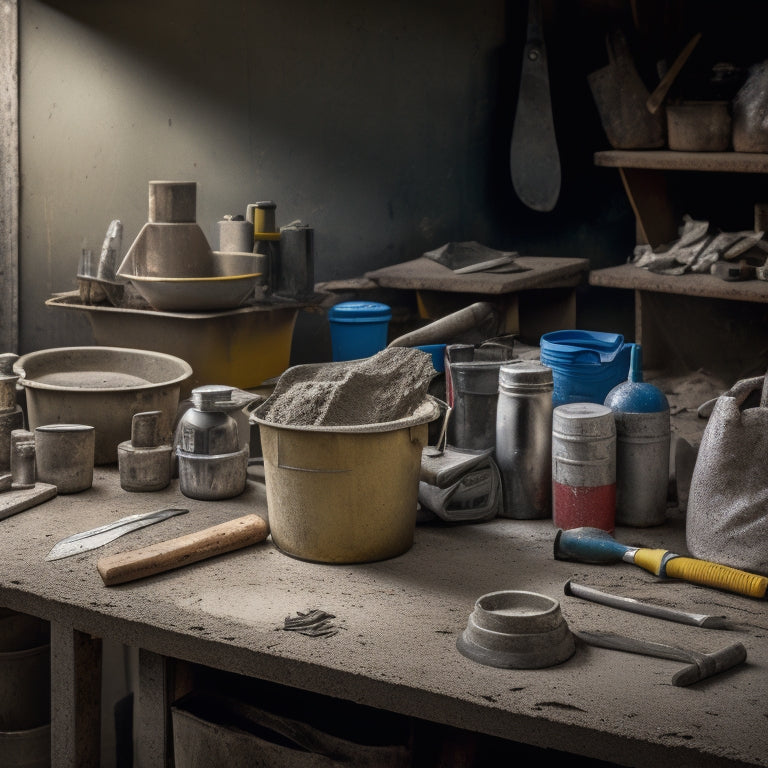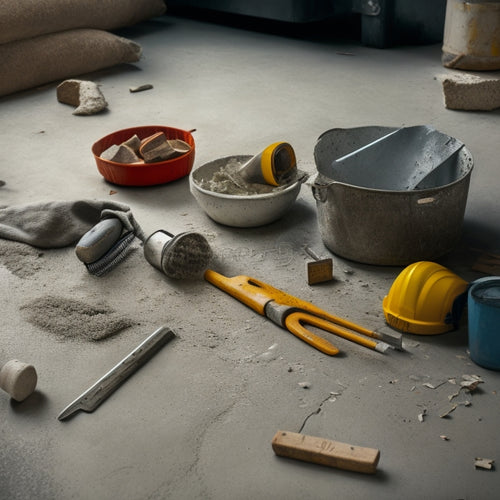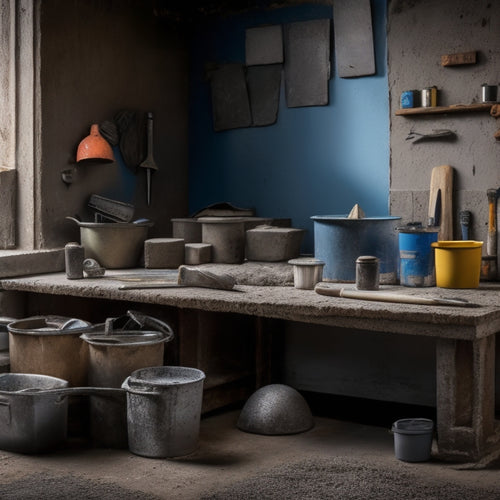
What Are the Best Concrete Crack Filling Tools
Share
When filling concrete cracks, you'll need a range of specialized tools to guarantee a successful and durable repair. Start with sturdy crack filling chisels and gouges to remove debris and widen cracks, followed by concrete crack injection tools to inject epoxy or polyurethane resins. Epoxy applicator guns, crack cleaning brushes, mixing and measuring tools, and sealant application tools are also essential. Don't forget to prioritize safety with protective gear like eyewear and gloves. With the right tools, you'll be well-equipped to tackle crack filling projects; now, learn how to select the best tools for your specific needs and guarantee a flawless finish.
Key Takeaways
• Sturdy chisels and gouges are essential for removing debris and widening cracks for a strong bond.
• Crack injection kits must include tools for injecting epoxy or polyurethane resins with precise flow control.
• Epoxy applicator guns with adjustable flow control ensure precise application and minimize waste.
• Crack cleaning brushes with stiff bristles and curved heads effectively remove debris and dirt from tight spaces.
• Mixing and measuring tools, such as sturdy buckets and digital calipers, ensure accurate proportions for a durable repair.
Crack Filling Chisels and Gouges
When tackling concrete crack repair, you'll need sturdy crack filling chisels and gouges to effectively remove loose debris and widen the crack to prepare it for filling. These tools are essential for ensuring a proper bond between the old concrete and the new filling material. To achieve accurate crack width measurement, you'll want to choose chisels with precision-ground edges, allowing you to remove material incrementally.
Chisel material types also play a vital role in crack filling. Carbon steel chisels, for instance, offer excellent durability and resistance to corrosion, making them ideal for heavy-duty applications. On the other hand, tungsten carbide-tipped chisels provide exceptional hardness and wear resistance, making them perfect for precision work.
Gouges, typically made from high-carbon steel, are designed for scooping and removing debris from the crack. By selecting the right combination of chisels and gouges, you'll be able to efficiently widen the crack, remove loose material, and achieve a precise crack width measurement – all vital steps in ensuring a successful concrete crack repair.
Concrete Crack Injection Tools
Your crack injection kit should include a range of tools specifically designed to inject epoxy or polyurethane resins into the crack, allowing you to effectively seal and repair the damaged area.
These tools are essential for successful crack injection methods, as they enable you to precisely control the flow of resin into the crack.
You'll need injection ports, which are small devices that attach to the surface of the concrete and allow you to inject the resin into the crack.
You'll also need a variety of injection tips, which come in different sizes and shapes to accommodate different crack widths and depths.
Additionally, your kit should include a supply of epoxy types, such as low-viscosity or high-viscosity epoxies, depending on the specific requirements of the job.
With the right tools, you'll be able to achieve a successful crack injection, resulting in a strong and durable repair.
Epoxy Applicator Guns Needed
What types of epoxy applicator guns will you need to guarantee a smooth, consistent resin flow and precise control during the crack filling process?
As a professional, you understand the importance of selecting the right tool for the job. When it comes to epoxy application, the type of gun you use can make all the difference.
You'll want to evaluate the following factors when choosing an epoxy applicator gun:
-
Epoxy types: Will you be working with low-viscosity, high-flow epoxies or thicker, more viscous materials?
-
Application techniques: Are you using a gravity-feed or pressure-feed method?
-
Flow control: Do you need a gun with adjustable flow control for precise application?
- Material handling: Will you be working with large quantities of epoxy, requiring a high-capacity gun?
Crack Cleaning Brushes Essential
Before filling cracks with epoxy, you'll need to confirm the area is free of debris and contaminants, which is where crack cleaning brushes come into play. Effective crack cleaning techniques rely on the right tools, and brushes are an essential part of the process.
When selecting a crack cleaning brush, consider the material type. Nylon brushes are gentle on surfaces and suitable for small, shallow cracks. Stiffer brushes made from polypropylene or polyester are better suited for larger, deeper cracks. You may also opt for a brush with stiff bristles and a curved or angled head to reach into tight spaces.
Regardless of the material or design, your brush should be sturdy enough to dislodge dirt and debris without scratching the surrounding concrete. Use your brush to sweep away loose particles, and then follow up with a vacuum or compressed air to remove any remaining dust.
Mixing and Measuring Tools
When preparing to fill concrete cracks, you'll need to guarantee you have the right mixing and measuring tools to get the job done efficiently.
You're about to learn how a sturdy mixing bucket and accurate measuring devices can make all the difference in achieving a successful repair.
Mixing Bucket Essentials
You'll need a sturdy mixing bucket, a heavy-duty mixing stick, and a set of measuring cups or a digital scale to accurately mix and prepare your concrete crack filler. When it comes to mixing bucket essentials, the right materials and tools can make all the difference in achieving a successful repair.
The bucket material is vital, as it can affect the mixing process and the final product. Here are some key considerations for mixing bucket materials:
-
Ruggedness: A durable bucket can withstand the rigors of mixing and handling heavy materials.
-
Non-reactive: A bucket that won't react with the concrete or crack filler is essential to prevent contamination.
-
Easy to clean: A smooth, non-porous surface makes cleaning a breeze, reducing the risk of residual material affecting future mixes.
- Size and shape: A bucket with a comfortable size and shape allows for efficient mixing and minimizes material waste.
Accurate Measuring Devices
With the right mixing bucket in place, you can focus on accurately measuring your concrete crack filler components using reliable measuring devices that guarantee a precise mix ratio.
To achieve this, you'll need measuring tools that provide accurate readings and minimize human error. Digital calipers are an excellent choice for measuring the width and depth of cracks, as well as the thickness of filler materials. These precision instruments can provide readings accurate to 0.01mm, ensuring your mix ratio is spot on.
When measuring larger areas or distances, consider using a laser distance meter. These devices can quickly and accurately measure distances up to 100 meters, making them ideal for large-scale projects.
By combining digital calipers with a laser distance meter, you'll have a thorough measuring system that covers all your concrete crack filling needs. Remember, precise measurements are critical in achieving a strong, durable bond between the filler material and the surrounding concrete.
Sealant Application Tools Required
To successfully fill concrete cracks, you'll need a range of sealant application tools that facilitate efficient and precise sealant placement. The type of sealant you're working with will influence the tools you require, but there are some essentials that apply across various sealant types and application techniques.
Here are the must-haves for your toolkit:
-
Caulk guns: For applying sealants in bead form, such as silicone or acrylic-based sealants.
-
Pour pots: For pouring sealants into large cracks or joints, ideal for epoxy-based sealants.
-
Injection guns: For injecting sealants into tight spaces or hairline cracks, suitable for polyurethane-based sealants.
- Spreader tools: For smoothing out excess sealant and achieving a uniform finish.
With these tools, you'll be well-equipped to tackle various concrete crack filling projects.
Remember to choose the right tool for the specific sealant type and application technique you're using to guarantee a successful fill. By doing so, you'll achieve a strong, long-lasting bond that will withstand the elements and extend the lifespan of your concrete structure.
Safety Gear for Crack Filling
When you're preparing to fill concrete cracks, you're not just gathering tools - you're also gathering safeguards.
You'll need to shield yourself from potential hazards, and that starts with the right protective eyewear and durable gloves.
Protective Eyewear Essentials
You require impact-resistant safety glasses or goggles that meet ANSI Z87.1 standards to shield your eyes from flying debris and concrete particles during crack filling operations. Eye safety is of paramount importance, as even a small particle can cause serious eye damage or blindness.
When selecting protective eyewear, consider the following essential features:
-
Lens material: Polycarbonate or Trivex lenses offer superior impact resistance and optical clarity.
-
Frame design: Look for frames with a secure fit, wraparound protection, and ventilation to minimize fogging.
-
Coatings: Anti-fog, scratch-resistant, and UV protection coatings enhance lens durability and visibility.
- Certification: Verify your eyewear meets ANSI Z87.1 standards for high-velocity impact protection.
Durable Glove Options
Your hands are your most valuable assets during concrete crack filling, and durable gloves are vital for protecting them from harsh chemicals, abrasion, and puncture wounds. As you work with concrete, you'll encounter various hazards that can cause injuries, from skin irritation to cuts and punctures. To guarantee your hands remain safe and protected, you need gloves that can withstand the demands of crack filling.
Here are some durable glove options to take into account:
| Glove Type | Material | Benefits |
|---|---|---|
| Nitrile Gloves | Synthetic rubber | Latex-free, resistant to chemicals and abrasion |
| Latex Alternatives | Neoprene or PVC | Hypoallergenic, flexible, and puncture-resistant |
| Heavy-Duty Work Gloves | Durable synthetic materials | Reinforced palms, fingers, and thumbs for added protection |
| Cut-Resistant Gloves | High-performance fibers | Protection against cuts and slashes from sharp objects |
When choosing gloves, think about the specific hazards you'll face during crack filling and select gloves that offer the necessary protection. Remember, your safety is paramount, and investing in durable gloves is a vital step in preventing injuries and guaranteeing a successful project.
Frequently Asked Questions
Can I Use a Hair Dryer to Speed up the Drying Process?
When you're working with concrete crack fillers, you might wonder if using a hair dryer can speed up the drying process.
While it's tempting to try, it's not recommended. Using a hair dryer can compromise safety, causing the filler to dry too quickly and unevenly. This can lead to weak bonds and potential cracks.
Instead, follow the manufacturer's instructions for recommended drying time, and prioritize a slow, controlled cure for best results.
How Do I Prevent Epoxy From Dripping on Surrounding Surfaces?
When applying epoxy, you'll want to prevent drips on surrounding surfaces. To do this, master epoxy application techniques by using surface protection methods.
Mask off areas with tape and plastic sheets, ensuring a tight seal. Apply a release agent to prevent epoxy bonding.
Additionally, use a dripless nozzle or a pouring pot with a small opening to control the flow. By following these techniques, you'll achieve a precise, professional finish.
What Is the Ideal Temperature for Filling Concrete Cracks?
When filling concrete cracks, you'll want to guarantee ideal conditions for a strong, durable bond.
Temperature plays an essential role, as it affects the epoxy's flow, cure time, and ultimate strength.
Aim for a temperature range of 60°F to 80°F (15°C to 27°C), as this allows for peak flow and minimizes temperature effects on the epoxy's properties.
Can I Fill Cracks During the Winter Months or in Cold Weather?
As you prepare to tackle concrete crack filling, you're likely wondering if winter's chill will hinder your progress.
Can you fill cracks during the winter months or in cold weather? The answer is yes, but with caution.
Winter concrete requires special considerations, as cold temperatures can affect the filler's curing process.
Verify the concrete is dry, and the crack is clean before applying the filler, and follow the manufacturer's instructions for cold-weather application.
How Long Does It Take for the Filled Cracks to Fully Cure?
When you fill cracks, you're likely wondering how long it takes for the filled cracks to fully cure.
The curing time depends on factors like crack depth and environmental conditions.
For shallow cracks, curing can take anywhere from a few hours to a few days.
Deeper cracks may require several weeks or even months to fully harden.
You'll need to wait until the filled material reaches its full strength before exposing it to heavy traffic or harsh weather.
Conclusion
You've equipped yourself with the right concrete crack filling tools:
-
Crack filling chisels and gouges to widen and prepare cracks,
-
Concrete crack injection tools to inject sealants,
-
Epoxy applicator guns to apply epoxy-based sealants,
-
Crack cleaning brushes to remove debris,
-
Mixing and measuring tools to prepare sealants,
-
Sealant application tools to apply sealants,
- Safety gear to protect yourself.
Now, you're ready to tackle any concrete crack filling task with confidence, precision, and efficiency, ensuring a successful and long-lasting repair.
Related Posts
-

What Tools Do I Need for Concrete Wall Repair
As you prepare for a concrete wall repair job, you'll need a variety of tools to guarantee a successful outcome. Star...
-

Top 10 Concrete Repair Tools for Small Fixes
You'll need the right tools to tackle small concrete repairs efficiently and effectively. When it comes to small fixe...
-

Top Tools for Beginners in Concrete Masonry Coating
You're about to begin a concrete masonry coating project, and having the right tools is essential. Start with essenti...


